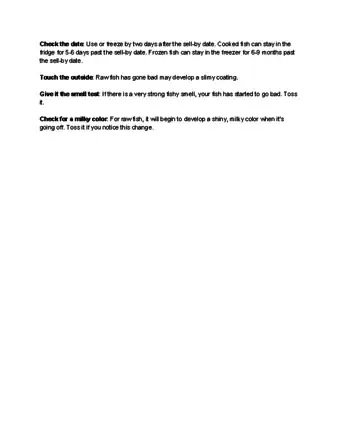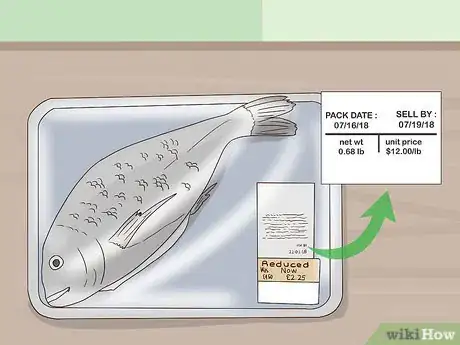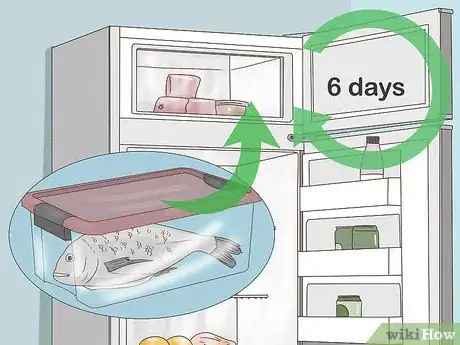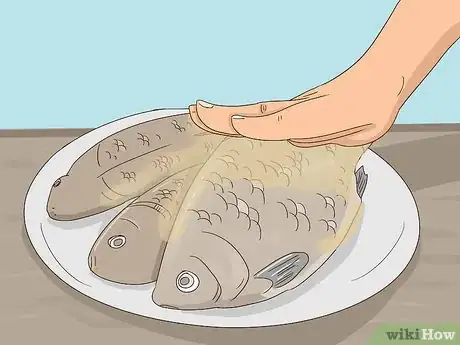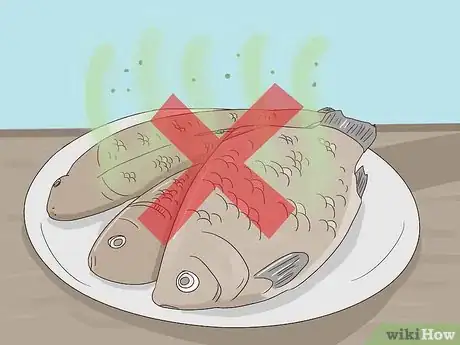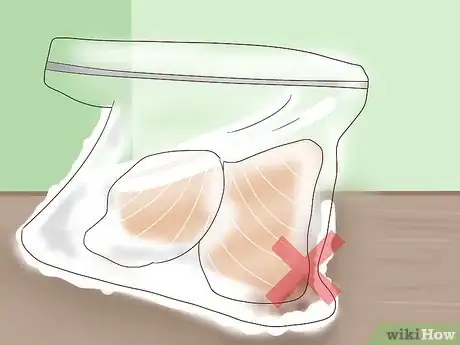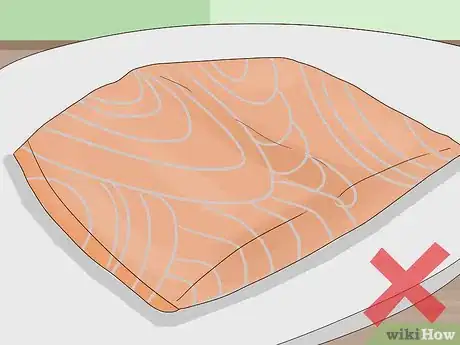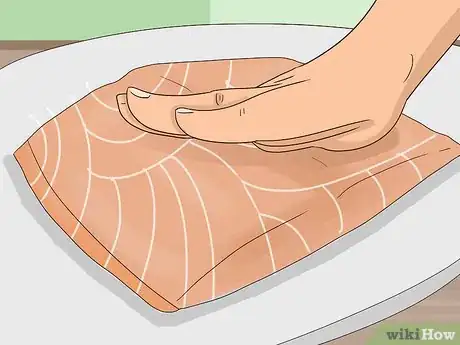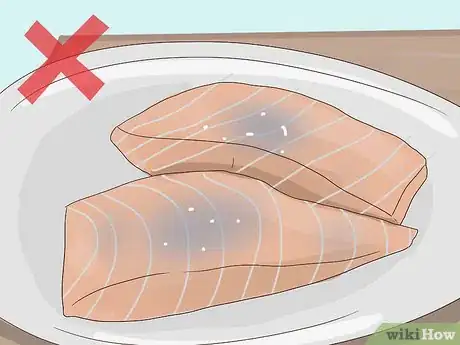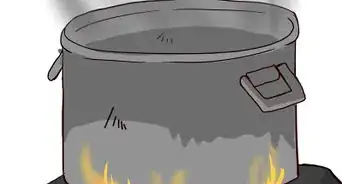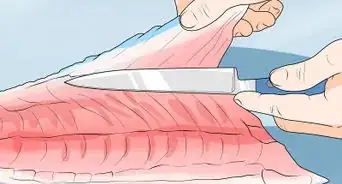This article was co-authored by Ollie George Cigliano. Ollie George Cigliano is a Private Chef, Food Educator, and Owner of Ollie George Cooks, based in Long Beach, California. With over 20 years of experience, she specializes in utilizing fresh, fun ingredients and mixing traditional and innovative cooking techniques. Ollie George holds a BA in Comparative Literature from The University of California, Berkeley, and a Nutrition and Healthy Living Certificate from eCornell University.
There are 7 references cited in this article, which can be found at the bottom of the page.
wikiHow marks an article as reader-approved once it receives enough positive feedback. In this case, 93% of readers who voted found the article helpful, earning it our reader-approved status.
This article has been viewed 665,094 times.
Fish tends to keep well in either a freezer or a refrigerator, and it can be stored in either before being eaten. However, the meat will eventually spoil, at which point it’s no longer safe or healthy to cook with. In order to tell if fish has gone bad, you’ll need to take into account the sell-by date printed on the packaging, the place the fish has been kept, and the texture and smell of the fish. To avoid food poisoning, it’s best to discard fish once it shows any signs of spoiling.
Steps
Signs Fish Has Gone Bad
Reading the Sell-By Date
-
1Toss refrigerated raw fish 2 days after the sell-by date. Raw fish doesn’t last very long in a refrigerator, and it begins to go bad soon after the sell-by date. Look for the sell-by date on the packaging. If more than 1 or 2 days have passed since that date, throw the fish out.[1] [2]
- If you’d like to delay the expiration of refrigerated fish, put it in the freezer.
- If the fish has a use-by date rather than a sell-by date, avoid keeping the fish past that date. “Use-by” indicates that fish will begin to spoil if it’s not eaten by the printed date.
-
2Keep cooked fish in your fridge for 5 or 6 days past the sell-by date. If you’ve bought cooked fish—or cooked your own fish—and then stored it in the refrigerator in an airtight container, it will keep longer than raw fish. If you haven’t eaten the fish after 5 or 6 days past the sell-by date, though, it will need to be discarded.[3]
- If you know in advance that you’re not going to use the cooked fish before it expires, put it in the freezer to delay the expiration.
- If you’re planning to discard the fish’s original packaging once it’s cooked, and then refrigerate the fish, write down the sell-by date so you don’t forget it after you’ve thrown the packaging away.
- You can write the sell-by date on a sticky note that you then attach to the Tupperware the fish is stored in. Alternately, write the date on a notepad that you keep on the door of your fridge.
Advertisement -
3
Inspecting the Fish
-
1Feel for a slimy coating on the raw fish. As fish ages and begins to go bad, its outer surface will become wetter and eventually develop a thin layer of slime. This is a good sign that your fish has begun to spoil. Once fish has fully spoiled, the slimy moisture on the meat will feel thick and slippery to the touch.[6]
- Discard fresh fish as soon as you notice the beginning of this slimy texture.
- Cooked fish will not develop a slimy coating, even after it’s started to go bad.
-
2Smell for a pungent fishy aroma. All fish—raw or cooked—smells like fish. However, refrigerated fish that has started to go bad will have an increasingly fishy smell.[7] If given enough time, this potent fish smell will develop into the putrid smell of rotting meat.[8]
- As fish continues to spoil, its pungent fish smell will grow stronger and stronger. It’s best to discard fish as soon as it starts to smell “off.”
-
3Inspect the raw fish for a milky color. Fish meat is typically light pink or white in color, with a thin, clear film of liquid. As fresh or refrigerated fish ages and begins to go bad, the meat will take on a glossy, milky color. The milky parts of the fish may also take on a blue- or gray-ish tint.[9]
- If you’ve already cooked your fish, it will not develop a milky color. This sign of expiration applies only to raw fish.
- If you have a whole fish, the eyeballs will look cloudy if it's gone bad.[10]
-
4Check for signs of freezer burn. If you’ve kept fish in the freezer for over 9 months, it may begin showing signs of freezer burn. Look for crystallized peaks of ice that have formed on the surface of the fish, and note any discolored patches as well.[11] Discard freezer-burned food.
- Freezer-burned food is still technically edible, and it will not make you sick. However, fish will lose most of its flavor and take on a grainy texture as freezer burn sets in.
Identifying Expired Salmon
-
1Note if the white lines in the meat disappear. Salmon, unlike most other kinds of fish, is well known for the thin white lines which separate the layers or flakes of its meat. These lines indicate that the fish is still fresh and edible. If you notice that these white lines have disappeared—or if they’ve turned to a more gray color—the salmon has likely gone bad.[12]
-
2Press the salmon to see if it’s still firm. Edible, fresh salmon should be firm to the touch. If salmon in your refrigerator has become squishy, mushy, or unexpectedly soft in texture, it’s likely expired.[13]
- The white lines between flakes of salmon can indicate its firmness in addition to its freshness. Once the lines have faded, the meat is all but guaranteed to be mushy.
-
3Inspect the salmon for discolored spots on the meat. Unlike other types of fish, as salmon ages and begins to go bad, it will develop discolorations. Look over the surface of the meat. If you see any spots that are not the healthy pink color of most salmon, your fish has likely expired.[14]
- Most of the discolorations you’ll find on salmon will be dark. However, spoiled salmon can also have small white-ish patches.
Community Q&A
-
QuestionIs cooked fish that smells of ammonia safe to eat?
 Community AnswerAs long as the flesh is still firm and the skin is shiny rather than slimy, the fish is still fine to cook and eat. If your seafood smells overpoweringly of ammonia, or is mushy, slimy or otherwise questionable, discard it. It is better to be safe than sorry.
Community AnswerAs long as the flesh is still firm and the skin is shiny rather than slimy, the fish is still fine to cook and eat. If your seafood smells overpoweringly of ammonia, or is mushy, slimy or otherwise questionable, discard it. It is better to be safe than sorry. -
QuestionWhy does my cod have an ammonia taste after I just cooked it?
 Community AnswerSprinkle salt all over on your cod before you cook/bake/grill/fry it. Leave it on for at least 20 minutes. Then rinse and cook as usual. The salt will draw out any unwanted bad tastes and bring out the best of its flavor.
Community AnswerSprinkle salt all over on your cod before you cook/bake/grill/fry it. Leave it on for at least 20 minutes. Then rinse and cook as usual. The salt will draw out any unwanted bad tastes and bring out the best of its flavor. -
QuestionWhy does my cooked salmon have a pungent smell?
 Community AnswerFresh salmon has a mild scent, so if yours smells pungent or ammonia-like, it's probably bad. You can also inspect the surface for a white, translucent skin. If you see a milky film on your salmon, get rid of it. You'll know cooked salmon is bad if it has a foul odor and slimy texture.
Community AnswerFresh salmon has a mild scent, so if yours smells pungent or ammonia-like, it's probably bad. You can also inspect the surface for a white, translucent skin. If you see a milky film on your salmon, get rid of it. You'll know cooked salmon is bad if it has a foul odor and slimy texture.
Warnings
- When in doubt, throw out fish that you think may have gone bad. It’s not worth the risk of developing a case of food poisoning.⧼thumbs_response⧽
References
- ↑ Ollie George Cigliano. Private Chef & Food Educator. Expert Interview. 30 August 2021.
- ↑ http://www.eatbydate.com/proteins/seafood/fish-shelf-life-expiration-date/
- ↑ http://www.eatbydate.com/proteins/seafood/fish-shelf-life-expiration-date/
- ↑ http://www.eatbydate.com/proteins/seafood/fish-shelf-life-expiration-date/
- ↑ http://www.fieldandstream.com/blogs/the-wild-chef/seven-tips-for-freezing-fish
- ↑ http://www.businessinsider.com/expiration-dates-are-bogus-heres-how-to-tell-if-food-has-gone-bad-2016-7/#uncooked-seafood-not-sushi-it-starts-to-smell-abnormally-fishy-11
- ↑ Ollie George Cigliano. Private Chef & Food Educator. Expert Interview. 30 August 2021.
- ↑ http://www.businessinsider.com/expiration-dates-are-bogus-heres-how-to-tell-if-food-has-gone-bad-2016-7/#uncooked-seafood-not-sushi-it-starts-to-smell-abnormally-fishy-11
- ↑ http://www.eatbydate.com/proteins/seafood/fish-shelf-life-expiration-date/
- ↑ Ollie George Cigliano. Private Chef & Food Educator. Expert Interview. 30 August 2021.
- ↑ http://globalnews.ca/news/3649115/how-to-tell-if-the-food-in-your-freezer-has-gone-bad/
- ↑ https://cookthestone.com/signs-spoiled-salmon/
- ↑ https://cookthestone.com/signs-spoiled-salmon/
- ↑ https://cookthestone.com/signs-spoiled-salmon/
- ↑ http://www.eatbydate.com/proteins/seafood/fish-shelf-life-expiration-date/
- ↑ http://www.eatbydate.com/proteins/seafood/how-long-does-salmon-last-shelf-life/
About This Article
To tell if fish has gone bad, touch your raw fish to see if it’s slimy, which happens when fish starts to spoil. You can also smell your fish. If it has an increasingly fishy smell or starts to smell like rotten meat, it has gone bad. You can look at your fish, too. Your fresh fish will be light pink or white, but if your fish starts to look glossy or milky, or has a bluish or grayish tint, it’s bad. Looking at salmon? If it’s no longer firm or doesn’t have its typical white lines, don’t eat it! To learn how to tell if fish has gone bad by reading sell-by dates on packages, scroll down!
